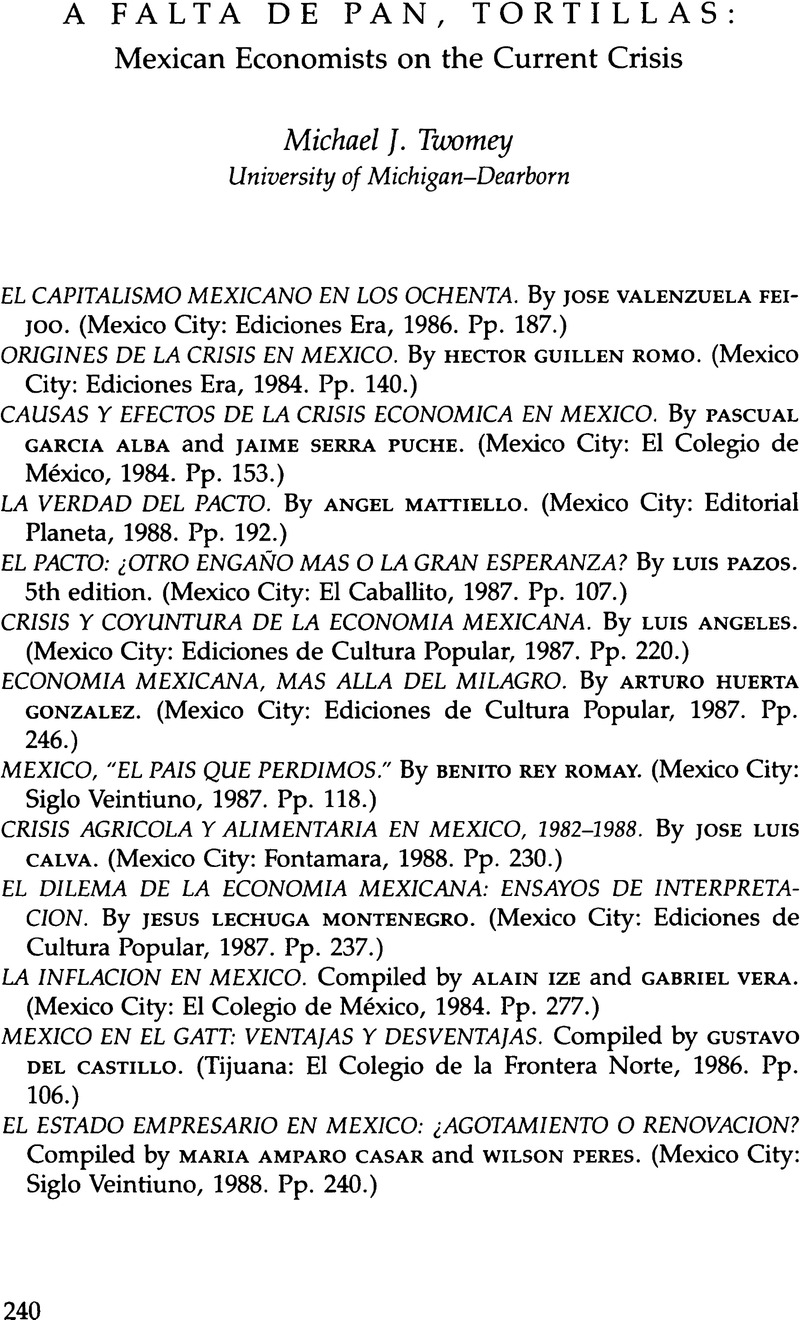No CrossRef data available.
Published online by Cambridge University Press: 12 October 2022

1. See the articles by Trejo Reyes and Silos Alvarado in El sistema económico mexicano, edited by Héctor E. González Méndez (Mexico City: La Red de Jonas, 1982); the introduction to the first number of CIDE's Economía mexicana (1979); the books under review by Guillén Romo, Valenzuela Feijóo, Huerta González; or virtually any article in the first volume of González Casanova and Aguilar Camín's México ante la crisis (Mexico City: Siglo Veintiuno, 1985). The relevant contrast is with books such as Leopoldo Solís's La realidad económica mexicana (Mexico City: Siglo Veintiuno, 1970) or the articles by Víctor Urquidi and David Ibarra in El perfil de México en 1980 (Mexico City: Siglo Veintiuno, 1970); both works were first published in 1970, and both recognize significant problems but no structural crisis. An important landmark was Carlos Bazdresch's paper, “Las causas de la crisis de 1982,” presented at the Colegio de México's 1983 Seminario sobre la Economía Mexicana (its proceedings were never published). In discussing the analyses of events leading up to 1982, Bazdresch contrasted a conservative analysis focusing on government deficits, exchange rate overvaluation, and errors in policymaking with a dependency reading emphasizing structural weaknesses of a long-term nature. He proceeds to argue for the correctness of the conservative position while affirming that longer-term problems indeed exist. While other influential economists in the government seldom provide detailed academic presentations of their positions, their frequent use of the term structural change in describing current goals, while also recognizing the need to balance the budget, reflects a position parallel to Bazdresch's synthesis.
2. The books under review by Angeles, Rey Romay, Huerta González, Valenzuela Feijóo, and Lechuga Montenegro provide similar recountings of the longer-term evolution of the crisis. For Rey Romay, “El país que perdimos” was the Mexico of Lázaro Cárdenas. An interesting contribution made by Valenzuela's book is its utilization of a series of linear statistical models to illustrate and expand on the historical description.
3. One exception is the article by Leopoldo Solís and Ernesto Zedillo, “Algunas consideraciones sobre la evolución reciente y perspectivas de la deuda externa de México,” which appeared in the first issue of El Colegio de México's Estudios Económicos (Jan.-June 1986). It follows the familiar methodology of Bela Balassa to conclude that during 1979–1981, the major factors were capital flight, extranormal increases in imports due to investments and other items, and increased interest rates. Alba and Serra appear to agree with this view in Causas y efectos de la crisis económica, although they attempt no serious analysis of the question (p. 60).
4. Thus Mexico presents a significant contrast with other countries in the region facing debt-payment problems, where little is heard about the need to change the overall development strategy. One of the key terms used in the Salinas campaign was modernización, although little effort was made to provide specific details. For an interesting set of comments on that term by leading Mexican social scientists, see the series of articles in Nexos, nos. 124–26.
5. The papers in the volume edited by Nora Lustig, Panorama y perspectiva de la economía mexicana (Mexico City: El Colegio de México, 1980), which resulted from a conference held during the oil boom, also reflect this dismay at the economic performance under former development plans. The first two sections of the collection discuss agriculture and industry pointedly from this perspective.
6. See José Luis Alberro, “La dinámica de los precios relativos en un ambiente inflacionaria,” Estudios Económicos, Oct. 1987:267–304.
7. The major point in Alba and Serra's Causas y efectos is that high levels of internally financed deficits have accompanied inflations throughout the postrevolutionary period. This point repeats the message of Antonio Gómez Oliver's Política monetaria y fiscal de México (Mexico City: Fondo de Cultura Económica, 1981). Although the causality tests in Ize and Vera's La inflación en México do not report uniformly positive support for a strict monetarist position, Alba and Serra prefer to emphasize periods like 1979–1982, when the government deficit as a percentage of the gross domestic product rose by 10 percent.
8. Inder Ruprah, “Déficit fiscal, inflación y crecimiento, 1983–1987),” Economía Mexicana 8 (1986):31–51.
9. Rolando Cordera, Desarrollo y crisis de la economía mexicana (Mexico City: Fondo de Cultura Económica, 1982).
10. On the abandonment of “gradualism,” see Banco de México, The Mexican Economy, 1988 (Mexico City: Banco de México, 1988), p. 6.
11. See David Ibarra, “Política y economía en América Latina: el trasfondo de los programas heterodoxos de estabilización,” Estudios Económicos, supplement, Oct. 1987.